|
Our
first impressions of Bangkok
Saturday
12th of may
The
taxi driver drove us from the airport to our hotel through a hole new
environment, heat and culture. The distance from the airport to the
city is about 30 km.
As a passenger you can choose if the taxi driver takes the toll way or
not. Of course, the extra cost has to be paid! On busy
hours this makes quite a difference in driving time.
We
soon experienced that Buddhism in Thailand is a force not only amid its
skyscrapers and shopping centers but also in every city home and in every
Thai.
Beautiful temples stand between high buildings and huge advertising
panels, small spirit houses are found in the compounds of virtually every
home, office, hotel and public building.
According to popular Thai belief a guardian spirit occupies the site of
any building and watches over the fortunes of those who live or work
there. The temples and spirit houses are to be shown due
respect. Daily offerings of food, flowers, candles and burning
incense are to be made to get protection and good
fortune.
Bangkok is indeed a town full of contradictions: old-modern, busy-calm,
dirty-extremely clean, business like-deep religious. Traffic is
terrible, streets are always full of cars, busses, tuktuks, and
motorcycles and the air isn't very healthy.
Our
hotel : Holiday Mansion
Voor ons verblijf in Bangkok hadden we het hotelaanbod op internet
uitgepluisd. We zochten geen luxehotel, maar een propere kamer met douche
voor een paar nachten. Toch hadden we enige reserves om een hotel via internet
te reserveren. Op een foto kan alles zo mooi worden voorgesteld, maar wat
het in werkelijkheid is, kan je eigenlijk nooit weten. Daarbij hadden we
ook geen idee van enige prijzen voor overnachtingen. Zijn internetrates
werkelijk interessant? Is ter plaatse reserveren niet goedkoper?
We hebben de gok gewaagd en via Asiatravel een hotelletje uitgezocht.
Aangekomen bij het bewuste Holiday Mansion Hotel werd ons vermoeden eerst
wel bevestigd: de aanblik van het hotel was inderdaad niet zo
overweldigend, modern en luxueus als het fotootje op internet liet
geloven. Maar de vriendelijke portier en bellboy deed dat onmiddellijk
vergeten.
Iedereen was zo behulpzaam en voorkomend, de reservatie was in orde en we
merkten dat ons internettarief inderdaad een stuk lager lag dan de
geldende prijzen (1300 THB - 2400 THB). De kamer was groot, luxueus en met
alles erop en eraan, maar wel wat ouder en donkerder dan in de
hotelbrochure.
Het enige minpunt was het uitzicht en de airco: we keken uit op de zijkant
van gebouwen en de airco maakte veel lawaai. Maar al bij al waren
we tevreden.
Het ontbijt en de maaltijden werden geserveerd in het aanpalende Palm Leaf
restaurant. Ook daar was de bediening voortreffelijk. Het restaurant is eenvoudig van
inrichting en kijkt uit op het zwembad dat zich
tussen de twee gebouwen in bevindt.
Het ontbijt is uitgebreid: allerlei soorten omelet, rijstgerechten, warme
groenten, pistolets, cornflakes en natuurlijk: fruit. De maaltijden van
het menu zijn lekker en gezond.


Click on the picture
The room
Toen we
om 15 u onze kamer betraden voelden we ons, na die vrijwel slapeloze nacht
in het vliegtuig en al die nieuwe indrukken, uitgeput. We hebben dan ook
een uurtje geslapen, ondanks de adviezen van de jetlagspecialisten.
Groot was onze verwondering toen we wakker werden. De blauwe en
zonnige lucht was veranderd in een donkere massa en het regende zowaar pijpenstelen.
Met de frisse temperatuur op onze kamer deed het ons denken aan het weer
in BelgiŽ, maar toen op het balkon kwamen beseften we al vlug dat dit
iets heel anders was. Het was alsof men in de hemel de warme douche even
had opengedraaid. De bui was redelijk snel overgewaaid en alles droogde
ook heel vlug terug op.
We besloten om de omgeving van het hotel eens te gaan verkennen. In de
zwoele avondlucht kwamen zoet-stinkende geuren ons tegemoet. Zoet vanwege
de talloze eetkraampjes, de wierook, het fruit en de bloemen; stinkend van
de uitlaatgassen van het alom tegenwoordige verkeer. Wandelende toeristen
zijn er blijkbaar wel een uitzondering want bijna elke taxi of tuktuk die
ons naderde, mindere even zijn snelheid en vroeg ons uitnodigend om plaats te
nemen.
De buurt waar we eerst in terecht kwamen was blijkbaar niet zo'n
toeristische attractie. Kleding, prularia, drank- of eetgelegenheden (of
wat daarvoor moet doorgaan), fruit en groentekraampjes staan in de open
benedenverdiepingen langs de kleine zijstraten opgesteld. Honden lopen er
kriskras doorheen. Toch wordt het afval netjes in een hoekje geveegd en
wordt de straat minutieus proper gehouden. In elke 'garage'
staat trouwens ook een televisietoestel en een versierd en verlicht
tempelschrijn. Prijzen van goederen worden volgens het uitzicht van de
koper bepaald. Daarna is het een kwestie van
afbieden.
Zo kochten we 2
'Camel' hemden voor 400 THB.
Ondertussen werd het donker (18u30), maar het was nog zalig warm.
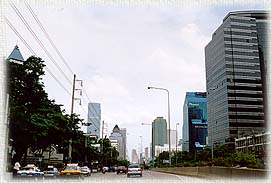
Even verder veranderde het uitzicht van de gebouwen, we kwamen in een iets
modernere buurt met grotere hotels en winkelketens en hogere buildings.
In een ultramodern winkelcomplex (Siam Center) zijn we uiteindelijk iets
gaan eten; Japans op de koop toe, en dat voor onze eerste avond in
Thailand! We waren echter te moe om uitgebreid te gaan eten.
Om 22u lagen we uitgeteld in ons bedje....
Sunday
13th of may
After
breakfast we decided to explore the City of Angels.
A skytrain-station (Phloen Chit) was located just 100 meter from our hotel.
The
Bangkok Transit System (BTS)
is one of the most advanced type of urban railways and is an
elevated heavy rail system running above the business district of Bangkok.

We
reden in de koele skytrain tot aan de Chao Praya rivier. Daar namen
we een riviertaxi.
Deze
Chao Praya Expres boten hebben een 20-tal aanlegsteigers en zijn een aanzienlijk
sneller vervoermiddel dan de taxi's in de drukke binnenstad. Bij zo'n
aanlegsteiger moet je wel snel en behendig zijn om de boot op tijd op en af te
springen.
Je kan ook een boot huren. Deze taxiservice wordt uitgevoerd door
zogenaamde "longtail" boten. Dit zijn fel gekleurde ranke, ca. 8
meter lange boten die uitgerust zijn met een enorme motor (soms
vrachtwagenmotors uit Japan ingevoerd) waarvan de schroef op een lange as
zit, zodat men in ondiep water de schroef omhoog kan halen.


We stapten af bij de Tha Tien pier, dicht bij Wat Pho.
Onmiddellijk werden we geconfronteerd met de toerisme-industrie. Nog
voor je de straat op kan moet je door een wirwar van eetkraampjes en
souvenirstalletjes. De geur van de gerechten die in grote pannen
worden klaargemaakt maken je wel hongerig, maar de hitte en de drukte
onder de zeilen van de kraampjes laten je smachten naar wat 'frisse' lucht.
Daar val je echter ten prooi aan een 50-tal tuk-tukchauffeurs die als
vliegen op je af komen. Voor 25 THB willen ze je graag een
stadsrondrit aanbieden met bezoeken aan de mooiste bezienswaardigheden. Nu
ja, als toerist in een onbekende stad lijkt
dat inderdaad een buitenkans. Een ritje met een tuk-tuk stond
sowieso al op ons programma en als die je dan voor een prikje naar de
mooiste tempels van de stad wil brengen... 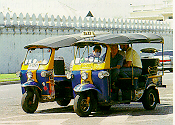 Wat
Suthat Our driver took us first to
the Wat
Sukhat. Temples in Bangkok are beautiful edifices.
Wat
Suthat is one of Thailand's six most important temples. The temple is
featured as Bangkok's tallest Wiharn and houses 14th century Buddha statue
from the Sukhothai period, Phra Sri Sakyamuni.
The temple is essentially of two big chapels, one almost square, while the
other long and narrow situated to the south of the first chapel.
Erected on a high terrace, the Wiharn is located in the center of a
courtyard enclosed in a covered gallery of 156 Buddha images in
meditation. The principle image is a bronze image of the Buddha in
subduing the Mara attitude. It is considered one of the largest
Sukhothai period Buddha images in existence with a knee span of 6.25
meters wide and a height of 8 meters. The remaining from the cremation of
King Rama VIII were interred in the pedestal of this Buddha image.
The great chapel lying on the South side is a long
building of 72 meters, the longest in Thailand. Phra Phuttha Trilokachet,
the principle Buddha image, was casted in alloy in the reign of King Rama
III. This subduing the mara image has a knee span of 5.16 meters and a
8.36 meters height making it one of the largest casted Buddha images of
the Bangkok period. In front is an assembly of eighty great disciples.
In front of the temple is the Giant Swing or Sao Ching Cha where a
Brahmanic ceremony had taken place until the early 20th century. In an
annual ceremony to celebrate the rice harvest, men used to ride on the
Giant Swing and try to grab a bag of silver coins attached to a pole.
Nowadays, only the teak arch remains.


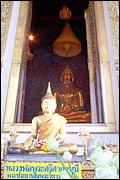
In de tempels heerst altijd een ingetogen sfeer en altijd zijn er wel
Thai die bloemen of wierook komen offeren en er komen bidden. Bij
het betreden van een tempel wordt je geacht je schoenen uit te doen en
even op de grond te gaan zitten. under construction
............
Wat
Pho or
Wat Phrachetuphon
Wat Pho or wat Phra
Chetuphon, the oldest and largest wat in Bangkok, was built in the 16th
century during the Ayutthaya period, almost completely rebuilt in 1781 by
King Rama I and had again a major restoration in 1839 under King Rama III.
Wat Pho came regarded as 'the first university in Thailand' when King Rama
III ordered texts to be inscribed on stone slabs around the temple which
people can learn and read from.
The main attraction of Wat Pho is the famous 'Reclining Buddha'. This
tremendous Buddha image is 46 meters long and 15 meters high. The statue
was to representing the Lord Buddha trying to overwhelm one of the
powerful demons and to convince him that his power is not the supreme. The
figure is modeled out of plaster around a brick core and finished in gold
leaf. Mother-of-pearl inlay ornaments the eyes and feet displaying 108
different auspicious characteristics of a Buddha. The building was built
later to cover the Buddha image.
The other important building in the compound is the main chapel or Ubosot.
Inside the Ubosot houses an ayutthaya-style bronze Buddha image in the
attitude of meditation, Phra Puttha Devapatimok. The pedestal of this
image contains the crematory ashes of King Rama I.
One of the images on display in the four Wihans surrounding the main
Ubosot in the eastern part of the compound is Phra Puttha Loknat Sasadajan,
a tall bronze standing Buddha image.
The galleries extending between the four Wihans feature no less than 394
gilded Buddha images. This images were selected from among 1,200 that were
brought down to Bangkok from either destroyed or deserted temples in the
country during the destructive war.




Wat
Radja
We ontmoetten een agent die na zijn werk
op weg naar huis was. We zochten een bepaalde straat en hij is met ons een
eindje om gelopen om ons de weg te tonen. Onderweg heeft hij ons nog een
tempel (Wat Radja) laten bezoeken waar toeristen normaal gezien niet zo maar
binnen mochten. Die tempel, vertelde hij ons, was een paar maanden voordien ook
bezocht door Prins Filip en prinses Mathilde bij hun bezoek aan Thailand.
Buddhism
Monday
14th of may
Royal
residence
Zoo
The Dusit Zoo (Khao Din) is a popular
place for families with children. The zoo and the park are located
on the Rama V Road en tegenover het oude parlement.

Parliament
Dit
marmeren gebouw in Italiaanse stijl is gebouwd in 1907 als de troonzaal
van koning
Chulalongkorn
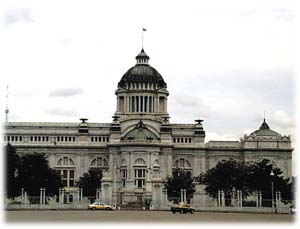

Canal
Wat
Arun
The Temple of Dawn or Wat
Arun is named after the Indian god of dawn, Aruna. It is located on the
west bank of the Chao Phraya River. King Taksin chose this 17th century
Wat for his royal temple and palace.
King Rama II and King Rama III reconstructed and enlarged the main prang
of the temple to its present height of 74 meters.
Today, Wat Arun has a long prang and four minor towers symbolizing Mount
Meru, the terrestrial representation of the thirty-three heavens. The
Prangs are covered with pieces of porcelain, which Chinese boats coming to
Bangkok used as ballast.
The main Prang has steep steps leading to the two terraces that form the
base of the Prang. The different layers, or heavens, are supported by
half-humans, and frightening demons. Pavilions on the first platform
contain statues of the Buddha at the most important stages of his life,
while the Hindi god Indra, his thirty-three headed elephant, stands guard.
The beauty of the architecture and the fine craftsmanship declare its
status as a temple of the first grade and one of the most outstanding
temples of Thailand.


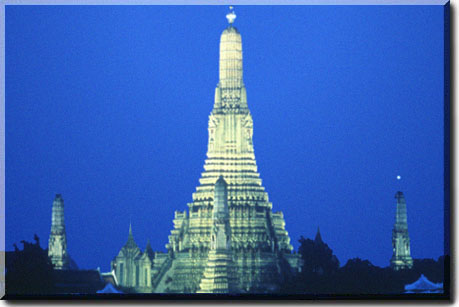
Tuesday
15 th of may
At 8:40
our plane took of to Bali, so we had to get up early.
|












